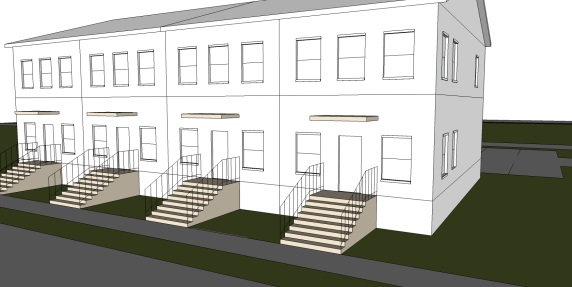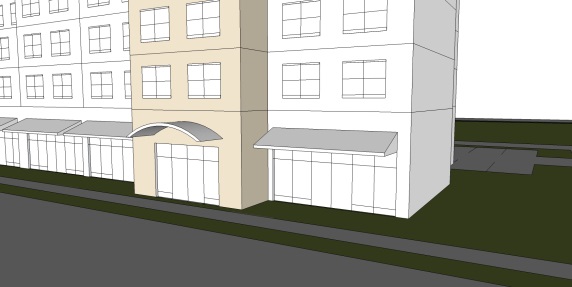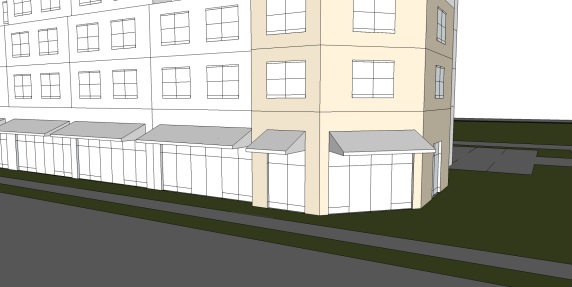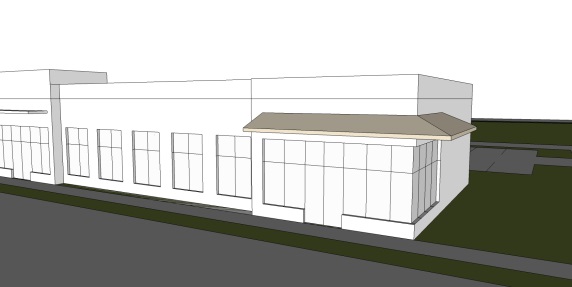4.8.7. FOUR-SIDED BUILDING DESIGN.
A. Intent. Four-sided building standards are provided to eliminate the common treatment of “backs” of buildings. There shall be a hierarchy to building façades, but depending on what each façade orients to there may or may not be a “back” side. For example, when a façade of a building orients to open space or a residential district, that façade shall employ architectural interest due to its high visibility, even if the façade does not include a main entry.
B. Applicability. The following standards apply to construction of all new primary buildings, and to all additions to and renovations of existing primary buildings that increase the gross floor area by 25 percent or more or 2,000 square feet, whichever is greater.
C. Building Face Hierarchy. A building's special architectural features and treatments shall not be restricted to a single façade. Each building face shall require a different degree of architectural treatment, commensurate with its degree of visibility from a public or private park, open space, or trail, or a public or private street right-of-way. Building faces shall be classified according to the hierarchy shown in Table 4.8-7.
|
Table 4.8-7 Building Face Naming and Descriptions |
||
|---|---|---|
|
A |
Primary Building Face |
This facade directly fronts a public or private street. It is typically the building face on which the primary entrance is located, and the face that will be viewed most frequently by pedestrian as well as automotive traffic. |
|
B |
Secondary Building Face |
This facade is typically perpendicular to the primary building face and located (a) on the side of a building, where it is viewed by pedestrian and automotive traffic, but less directly, or on the rear of a building that faces a park, open space, or trail. |
|
C |
Minor Building Face |
This facade is typically found at the rear of a building that does not face a park, open space, or trail, and that is viewed only from alleys, abutting lots, or indirectly from greater distances. |
D. Façade Character Elements.
1. In addition to any applicable Massing and Articulation standards, new buildings are subject to the following façade character requirements for four-sided design.
2. Façade materials shall wrap around a building corner a minimum of two feet when there is a change of façade material or color on two adjacent sides of the building.
3. Table 4.8-8 includes three categories for façade character elements. Each category includes a minimum number of required elements for each building face. This table may be used as a checklist for the Planning Director.
|
Table 4.8-8 Façade Character Elements for Four-Sided Building Design |
||||||
|---|---|---|---|---|---|---|
|
Mixed-Use and Multifamily Residential Districts |
Special Purpose Districts |
|||||
|
BUILDING FACE |
PRIMARY FAÇADE |
SECONDARY FACADE |
MINOR FACADE |
PRIMARY FACADE |
SECONDARY FACADE |
MINOR FACADE |
|
Massing |
||||||
|
General |
3 |
2 |
1 |
2 |
1 |
1 |
|
Wall off-set (min. 3 ft.) |
||||||
|
Wall/parapet height change (min. 3 ft.) |
||||||
|
Roof form change |
||||||
|
Upper floor stepback |
||||||
|
Wall notch (min. 12 in.) |
||||||
|
Materials |
||||||
|
General |
2 |
2 |
1 |
2 |
1 |
1 |
|
Change in material |
||||||
|
Change in color |
||||||
|
Change in texture |
||||||
|
Use of masonry (min. 40% of façade) |
||||||
|
Use of panelized materials (min. 40% of façade) |
||||||
|
Variety of window sizes |
||||||
|
Transparency and glazing (min 70% transparent glass) |
||||||
|
Human Scale |
||||||
|
General |
3 |
2 |
1 |
3 |
2 |
1 |
|
Architectural detailing |
||||||
|
Display cases on ground floor (for mixed-use) |
||||||
|
Building-mounted lighting fixtures |
||||||
|
Awnings or shutters |
||||||
|
Entry definition (pronounced massing/roof form, stoop, porch, etc.) |
||||||
|
Building corner enhancements |
||||||
|
Wall art |
||||||
|
Balconies |
||||||
|
Landscape wall/decorative screen for vines |
||||||
E. Entry Design. Each building shown in Table 4.8-9 shall incorporate primary entries to either primary and/or secondary building faces. Each entry shall be accentuated by using one of the methods shown in Table 4.8-9.
|
Table 4.8-9 Entry Options |
|
|---|---|
|
Entry Options for Residential Buildings with Individual Unit Access from Ground Floor |
|
|
a. Front Porch Front porches are common on single-family attached (townhouse) and other residential building types where individual units may be accessed from the ground floor. A front porch shall be raised a minimum of 24 in. off the ground and be at least partially open on three sides and include a roof overhead. It shall be large enough to accommodate seating for two people. |

|
|
b. Patio Patios are common on single-family attached (townhouse) and other residential building types where individual units may be accessed from the ground floor. They are also common for units that have to be accessible from the ground floor. A patio is less than 24 in. off the ground and shall be at least partially covered. A patio shall be large enough to accommodate seating for two people. |

|
|
c. Stoop Stoops are most common on single-family attached (townhouse) or stacked apartment building types. A stoop shall be raised a minimum of 36 in. off the ground. The landing of the stoop shall be a minimum of 30 square feet and be covered. |

|
|
Entry Options for Multifamily, Mixed-Use, Commercial and Industrial Buildings |
|
|
d. Projected Mass A projected mass entry includes a featured building form element where the main entry to a building is located. This is most common for building types that share a common entry, especially to service upper floors. The projected mass shall be a minimum of 2 ft. deep. The entrance shall be covered, either by an attached element or by recessing the doors into the building mass. |

|
|
e. Recessed Mass A recessed mass entry includes a featured building form element where the main entry to a building is located. This is most common for building types that share a common entry, especially to service upper floors. The recessed mass shall be inset a minimum of 2 ft. and shall be covered. |

|
|
f. Corner Entry A corner entry is naturally featured by being located in the most visible portion of a building. A corner entry could serve the ground floor and/or act as a common entry for an entire building. The building is usually chamfered or rounded (at least on the ground floor) to accommodate doors and/or storefront windows. |

|
|
g. Roof Form Variation Varying the roof form above the mass on which the entry is located enhances visibility to the main entrance. Roof form variation as a way to enhance an entry is most appropriate for lower-scaled buildings where the roof form is seen from the ground. A roof form variation shall be visibly different from adjacent building mass and form by varying overall roof form and/or height. |

|
|
h. Awning or Sun Shade Device Incorporate an awning or sun shade device to enhance and highlight a main entrance and to cover an entrance from rain and snow. Sun shade devices shall be used appropriately for solar control, i.e. they are not appropriate on north facades. |

|
(Ord. No. 2022-32 § 3, 07-11-2022; Ord. No. 2019-49 § 1, 08-19-2019)